If you don’t experience enough April showers this month, take a trip to the Art Institute of Chicago to see one of the museum’s most enduringly popular paintings: Paris Street; Rainy Day. The masterpiece by French impressionist Gustave Caillebotte captures the soggy French capital at an intersection near the Saint-Lazare train station. The monumental work stands at roughly seven by nine feet and hangs on its own wall in Gallery 201 at the top of the museum’s Grand Staircase on the east side of the building. No umbrella, no problem.
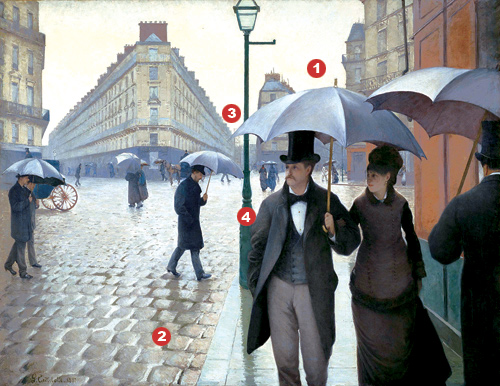
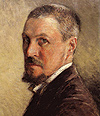 |
About the Artist: Gustave Caillebotte (1848-94) was born into an upper-crust Parisian family who had made their fortune in textiles. Caillebotte was
a lawyer, but after receiving a large inheritance, he decided to pursue painting and horticulture. He enrolled in the École des Beaux-Arts, where he met Pierre-Auguste Renoir and Claude Monet, of whom he later became a patron. He organized group impressionist shows including one in Paris in 1877, which featured his own Paris Street; Rainy Day.
How the painting got to Chicago: The Art Institute of Chicago bought it in 1964 for an undisclosed price. The purchase was brilliant and bold, says Gloria Groom, the Art Institute’s curator of 19th-century European painting, because the world had not yet recognized Caillebotte’s talent. In 1995, the painting was the signature piece at a French retrospective of Caillebotte. It remains one of the few Caillebottes in any public collection; most of the artist’s work is privately owned by his family.
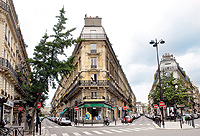 |
1. The setting: The couple in front are walking on the rue de Turin near its intersection with the rue de Moscou. The location, which still exists today, is north of the Saint-Lazare train station. Caillebotte owned property in this neighborhood. Today, a pharmacy (inset, green awning) at the intersection displays one of Caillebotte’s studies for Rainy Day behind the counter.
2. The technique: Caillebotte typically used a traditional technique of applying oil paint on canvas in a smooth way, without glazes or heavy, impasto strokes. But he also employed a more modern, impressionist style on the pavement stones, using exaggerated, broad brushstrokes to create very abstract geometric shapes.
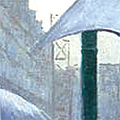 |
3. Scaffolding detail: At the time Caillebotte immortalized this intersection on canvas, Baron George Eugène Haussmann, a civic planner, had transformed the real Paris from a medieval city into a modern capital. Haussmann turned alleylike streets into broad boulevards and constructed sidewalks and sewer systems. The distant scaffolding (inset) indicates even more renovations to the facades.
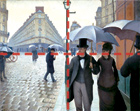 |
4. Composition and perspective: The lines of the lamppost and horizon divide the picture into quadrants (inset). The lamppost also divides the foreground from the middle and distant views. The people in the back ground get tiny too quickly-“Wacko,” says curator Gloria Groom of this fisheye perspective. But she adds: “that’s the brilliance
of a good painting.”
Paintings: (right) Gustave Caillebotte, French. Paris Street; Rainy Day, 1877. Oil on canvas. The Art Institute of Chicago: Charles H. and Mary F. S. Worcester Collection, 1964.336 Photograph: (inset) Lauren Greenwald


